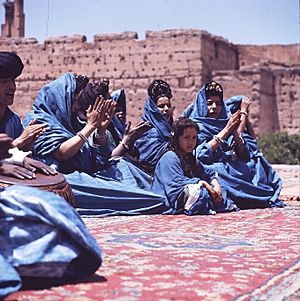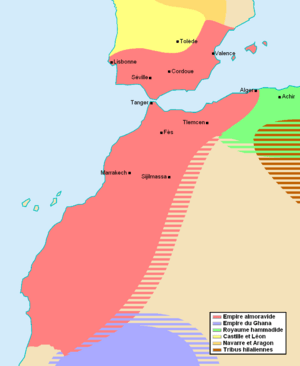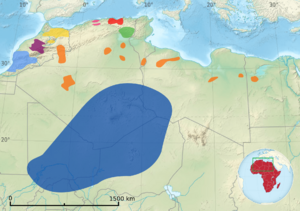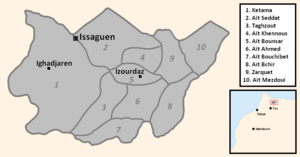Sanhaja facts for kids
The Sanhaja (in Berber: Aẓnag, plural Iẓnagen; in Arabic: صنهاجة, Ṣanhaja) were once one of the largest groups of Berber tribes. They were as important as the Zenata and Masmuda groups. Many tribes in countries like Algeria, Morocco, and Mauritania still use this name today, especially in its Berber form. You might also see them called Zenaga, Znaga, or Senhaja.
Contents
Different Sanhaja Groups
A famous historian named Ibn Khaldun explained that the name "Sanhaja" actually refers to three different main groups of tribes. It's important to know they weren't all the same group.
Sanhaja of the First Type
This group included tribes like the Kutama and Zawawa. They lived in the mountains of the Kabyle region in Algeria. Some of their areas, like Algiers and Constantine, no longer speak the original Kabyle language.
Many important ruling families came from this group, including:
- The Zirid Dynasty
- The Hammadid Dynasty
- The Fatimid Caliphate, which was a very powerful empire.
Sanhaja of the Second Type
This group was also known as Aznag or Iẓnagen. They were sometimes called the "Sanhaja of the veil" because they wore blue face coverings. This group included tribes like the Lemta and Lamtuna. They mostly lived near the Western Sahara and the Draa River.
The Al-Moravids, who built a large empire in North Africa and Spain, came from this group. The Aznag and Tuareg languages are linked to this region.
Sanhaja of the Third Type
This group was closely related to the Masmuda tribes. They spoke the Shilha language and mostly lived in the Atlas Mountains of Morocco.
The Al-Mohads, another powerful empire, and the Hafsid Dynasty came from this group.
Where Did They Come From?
Some old Arab historians said that Berber tribes like the Sanhaja came from the Himyarite Kingdom in ancient Yemen. The Sanhaja might have even said this themselves to gain more power and respect.
However, modern science, especially genetic testing, shows that this story is likely a myth. The main genetic markers of Berbers are different from those found in the Arabian Peninsula. This means the story was probably not true.
For example, one legend said that the ancestors of the Sanhaja traveled from a place called Hejaz, crossed the Nile River, and reached North Africa. There, their ancestor married a woman named Tāzikāy, who became the mother of the Sanhaja and Lamṭ tribes.
Their History

After the religion of Islam arrived, the Sanhaja tribes spread out across North Africa, reaching as far as the Senegal River and the Niger River.
From the 800s onwards, Sanhaja tribes settled in many parts of Morocco, including the Middle Atlas mountains and the Rif Mountains. Large groups, like the Kutama, also settled in central and eastern Algeria. The Kutama were very important because they helped create the Fatimids empire, which took over much of North Africa and parts of the Middle East.
The Sanhaja dynasties of the Zirids and Hammâdids ruled a region called Ifriqiya (parts of modern-day Tunisia, Algeria, and Libya) until the 1100s. They controlled many countries in the Maghreb region (Northwest Africa).
In the mid-1000s, some Sanhaja leaders returned from their Hajj (pilgrimage to Mecca). They invited a religious teacher named Ibn Yasin to teach their tribes. Ibn Yasin brought the tribes together to form the Almoravids alliance. This powerful group later founded Morocco and conquered parts of western Algeria and Al-Andalus (which is now part of Spain).

Over time, some Sanhaja tribes became farmers and fishermen. Others became religious leaders. Even though many of them started speaking Arabic and adopted Arab customs, they are believed to be descendants of the original Berber people who lived in the area before Arab tribes arrived in the 1100s.
The words Zenaga or Znaga are thought to be different ways of saying Zenata and Sanhaja in Arabic.
Sanhaja Today
Today, you can still find descendants of the Sanhaja people and their languages in the Middle Atlas mountains, eastern Morocco, northern Morocco (Rif), western Algeria, and the Kabyle regions.
The Zenaga, a small group believed to be from the Gudala tribe (the southernmost Sanhaja tribe), live in southwestern Mauritania and parts of northern Senegal.
See also
 In Spanish: Sanhaya para niños
In Spanish: Sanhaya para niños
- Masmuda
- Zenaga language
- Tekna
- Reguibat



